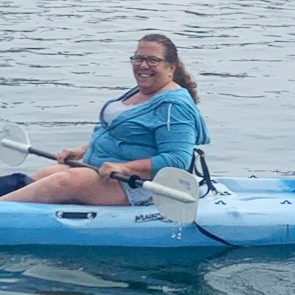
Angie West is a neuroscience nurse and director of the stroke program at MemorialCare Long Beach Medical Center. Her back pain began about three years ago due to rheumatoid arthritis, a disease that caused her immune system to attack her own joints, causing pain, swelling and stiffness.
Her pain reached the point where she could not walk from her office to the parking garage at Long Beach Medical Center without her feet going numb, at one point, it caused her to fall.
Angie had several surgeries in the past, but the thought of going through a spine surgery made her uneasy. Due to her rheumatoid arthritis, she’s had two knee replacements, procedures for shoulder pain, and now she was thinking about back surgery. Her back pain didn’t allow her to stand up straight, and if she didn’t go through with it, there was a potential for her to suffer worsening pain and walking ability, as well as possibly lasting nerve damage.
“I knew I had to overcome my fears, trust in my colleagues and go through a surgery that could change my life for the better,” says Angie. “I knew that Long Beach Medical Center had the latest technology and a surgeon with experience. That’s all I needed.”
In November 2021, Angie had her spine surgery done by Amandeep Bhalla, M.D., the medical director of the Spine Health Center at MemorialCare Long Beach Medical Center.
The MemorialCare Orthopedic & Spine Institute at Long Beach Medical Center provides the most accurate and precise spine surgery with the help of advanced technology like ExcelsiusGPS® - which like GPS in a car pre-surgically creates a navigation plan for spine surgery. ExcelsiusGPS® combines a robotic arm with full navigational capabilities into one adaptable platform for accurate alignment in spine surgery – preserving surgeon control, while improving screw accuracy and procedural time.
Angie was surgically treated for lumbar spinal stenosis, which is the narrowing of the spinal canal in the lower part of the back. Dr. Bhalla performed a laminectomy which removes a portion of the roof of the spinal canal to release pressure from the nerves. Then, an instrumented fusion was performed with the cutting-edge navigation technology ExcelsiusGPS® to help bones in the spine grow together and prevent the pain from reoccurring.
“Angie’s surgery was successful thanks to the help of the ExcelsiusGPS®, which allows us to safely and accurately navigate the surgery and the instrumentation,” says Dr. Bhalla. “It can shorten surgery times, minimize the size of incisions and improve accuracy. Angie was able to stand straight and walk right after surgery, and even walked upstairs the same day.”
After surgery and several days in the hospital, her journey to healing continued. Angie was placed in aquatic therapy to strengthen muscles, reduce swelling, and increase mobility. Angie did aquatic therapy multiple times a week for 12 weeks which consisted of cardio and stretching exercises with an instructor.
“Aquatic therapy has helped my whole body, and being in the water feels very comfortable,” says Angie. “Because of the surgery and aquatic therapy, I can walk farther and work without pain. I realized I didn’t need to feel uneasy as I was in good hands. Dr. Bhalla gave me my life back, and I am thankful to him and his team for helping me throughout the entire process.”
Ready to learn how spine pain impacts your life? Take our quick health risk assessment.